Vonda Urban: Difference between revisions
| (28 intermediate revisions by 2 users not shown) | |||
| Line 1: | Line 1: | ||
'''Vonda Urban''' was | [[File:Vonda Urban portrait.jpg|right|200px|thumb|Vonda Urban]] | ||
'''Vonda Urban''' was an independent teacher of [[Theosophy]] based in Chicago, Illinois. | |||
The most impressive thing about Vonda was her impersonal and equal treatment of everyone regardless of their failings as humans, part of Nature's evolution. Absolutely non judgemental.<ref>Richard Robb in email to Michael Conlin. 2023. Theosophical Society in America Archives.</ref> | |||
== Early life == | == Early life == | ||
Vonda Urban was born as Wanda Urbanovicz on [[December 8]], 1918 in Springfield, Massachusetts. She was the youngest child of Karolina Janik and Michael Urbanovicz. Michael had emigrated from southern Poland in 1904, and Carolina in 1906. They married on November 20, 2013, and settled in Massachusetts, where Michael worked as a baker and later as a salesman.<ref>1920 United States Federal Census.</ref><ref>1930 United States Federal Census.</ref> Their children were Olga (1914), Irene (1915), Witold (1917), and Wanda (1918).<ref>Karolina Janik in 1935 Illinois, U.S., Federal Naturalization Records, 1856-1991.</ref> | |||
<blockquote> | |||
They didn’t have much money; so young Vonda and her sisters Irene and Olga sold pond lilies and household items door to door to help support the family. | |||
In school, Vonda loved showing off, acting in the school plays and reciting poetry.<ref>Jon Knebel narrative. Written ca2011. Theosophical Society in America Archives.</ref> | |||
</blockquote> | |||
Olga moved to Chicago in the early 1930s, followed quickly by her sisters. Vonda and Irene shortened their surname to Urban, and according to their niece, "became city girls. They struck out on their own and made careers for themselves."<ref>Deborah Urban, quoted by Becky Schlikerman, "Vonda Urban, 1918-2011" ''Chicago Tribune'' June 12, 2011.</ref> | |||
<blockquote> | |||
They began by selling handmade, silkscreened greeting cards and wrapping paper (even selling it at Marshall Field's). Eventually Irene got married and Vonda, who had studied dance, started teaching at several venues, eventually landing at the preeminent Aragon Ballroom in 1954.<ref>Becky Schlikerman, "Vonda Urban, 1918-2011" ''Chicago Tribune'' June 12, 2011.</ref> | |||
</blockquote> | |||
Michael Urbanowicz died in 1942, and his wife Karolina and son Witold moved to Chicago. Vonda and her husband Galen "later took on the responsibility for caring for her brother Witold. To earn a living, and to help support her mother, Vonda worked as a part-time bookkeeper and accountant for many Chicago firms."<ref>Jon Knebel narrative. Written ca2011. Theosophical Society in America Archives.</ref> | |||
[[File:Cha cha backstage at Aragon Ballroom.png|right|250px|thumb|Dancing cha cha backstage at the Aragon Ballroom]] | |||
== Dance career == | == Dance career == | ||
[[File:Vonda_Urban_diagram.jpg|right| | Beginning in 1954, the vivacious Vonda Urban taught ballroom dancing at the elegant '''Aragon Ballroom''' in Chicago, and became something of a local celebrity. As many as 18,000 patrons visited the venue every week to enjoy the maple dance floor could could hold 8,000 at one time. Six nights a week, radio station WGN broadcast a nationwide hour-long program featuring the famous bands who were playing: the orchestras of Tommy Dorsey, Billy May, Eddy Howard, Teddy Phillips, Dick Jurgens, Chuck Foster, and Buddy Morrow. Lessons in the newest Latin dance styles such as mambo, bossa nova, rhumba, cha cha, and merengue were offered free every Sunday night, and the classic fox trot and waltz on Tuesdays, with Vonda Urban as the instructor. After marrying a band leader and music teacher, Galen Williams, on October 16, 1957, she played drums in his dance band – the first female drummer in that time. They divorced in the 1970s. | ||
[[File:Vonda Urban 1972 advertisement.png|right|160px|thumb|Advertisement in ''Daily Northwestern'', 1972]] | |||
[[File:Vonda_Urban_diagram.jpg|right|200px|thumb|Chains and Rounds diagram by Vonda Urban and Irene Stashinski]] | |||
== Theosophical work == | == Theosophical work == | ||
Vonda Urban was a truly independent student and teacher of [[Theosophy]], associated with Theosophists from the [[Point Loma]] tradition, the [[Theosophical Society (Adyar)|Adyar Theosophical Society]], and others, but did not join the organizations. She worked with the editors of independent Theosophical journals, [[Boris de Zirkoff|Boris de Zirkoff's]] [[Theosophia (periodical)|''Theosophia'']] and [[The Eclectic Theosophist (periodical)|''The Eclectic Theosophist'']], edited by W. Emmett Small and Helen Todd. She also wrote for the academic journal ''Theosophical History'' and for the journal of the [[Theosophical Society in America]]. | |||
<blockquote> | |||
Her mother was interested in spiritualism, and when attending a spiritualist gathering in Chicago, she heard [[George Cardinal LeGros]], a [[Point Loma]] Theosophist, speak on Theosophy. She told her daughters Irene and Vonda about him, and this led to their life long involvement with Theosophy. | |||
Vonda and Galen became close friends with Cardinal and his wife Elaine, and spent many evenings together. She called those 10 or 12 years the “wonder years.” At one lecture at Cardinal’s home in Chicago, she met [[ Boris de Zirkoff]], the grandnephew of [[Helena Petrovna Blavatsky|Madame Blavatsky]]. She would later become a researcher for Boris as he was compiling [[Collected Writings (book)|H. P. Blavatsky’s collected writings]] and working on his edition of her [[The Secret Doctrine (book)|''Secret Doctrine'']]. She found items he needed at the University of Chicago, Newberry Library, and the Field Museum of Natural History. She also helped proofread the final volumes and index of the [[Collected Writings (book)|''Collected Writings'']].<ref>Jon Knebel narrative. Written ca2011. Theosophical Society in America Archives.</ref> | |||
</blockquote> | |||
In 1972, Miss Urban began offering classes in "Esoteric Philosophy as set forth by H. P. Blavatsky and her teachers." She advertised in the ''Daily Northwestern'' and listed her telephone number in the Yellow Pages of the telephone directory under "Philosopher." She hosted five or six classes a week for the rest of her life. "She also taught an astrology class, where the group would read astrological charts. Altogether she taught approximately 1,000 pupils about the philosophy."<ref>Becky Schlikerman, "Vonda Urban, 1918-2011" ''Chicago Tribune'' June 12, 2011.</ref> One of her students, Jon Knebel, wrote: | |||
<blockquote> | |||
Vonda wrote many articles for Theosophical magazines including [[Theosophia]], [[The Eclectic Theosophist]], and [[Theosophical History]]. She lectured frequently at the Akbar Lodge in Chicago, and once or twice a year at the [[Olcott (campus)|Wheaton Illinois headquarters]] of The [[Theosophical Society in America]], several of the Wheaton lectures having been recorded. Vonda was famous for giving away books, pamphlets and recordings at her lectures, and would often have her audience read along with her as she quoted certain passages. She felt it might encourage them to continue their reading after her lecture was concluded. | |||
Vonda Urban guided and nurtured countless students of Theosophy over the past four decades. Well versed in Theosophy, she was always gentle and caring, always upbeat and inspiring, but also sternly concerned and involved with her fellow students’ growth in the mundane world. She charged us with leading lives that reflected the profound teachings we were studying. Her favorite passage from H. P. Blavatsky’s [[The Voice of the Silence (book)|Voice of the Silence]] was, “Thou canst not travel on [[Spiritual Path|the Path]] before thou hast become that Path itself.”<ref>Jon Knebel narrative. Written ca2011. Theosophical Society in America Archives.</ref> | |||
</blockquote> | |||
Her sister Irene Stashinski worked with her to develop some excellent diagrams depicting [[Chains and Rounds]] and other Theosophical concepts. Vonda, Irene, and Vonda's students Arnie Coleman and Norman Zuefle assisted in production of the fourteenth volume of the [[Collected Writings (book)|''Collected Writings'']] of Theosophical Society founder [[H. P. Blavatsky]].<ref>Preface to Volume XIV, page xxi.</ref> | |||
== Final years == | |||
[[ | Vonda continued teaching Theosophy almost to the end of her life. She died of pancreatic cancer on [[June 3]], 2011. | ||
== Additional resources == | == Additional resources == | ||
| Line 17: | Line 61: | ||
All of the following lectures were delivered at the Theosophical Society in America, in Wheaton, Illinois. | All of the following lectures were delivered at the Theosophical Society in America, in Wheaton, Illinois. | ||
* '''[https://archive.org/details/hpb-messianic-messenger Helena Petrovna Blavatsky: Messianic Messenger]''' October 1, 1991. Explores the relevance of Madame Blavatsky's life and teachings to modern times. | * '''[https://archive.org/details/hpb-messianic-messenger Helena Petrovna Blavatsky: Messianic Messenger]''' October 1, 1991. Explores the relevance of Madame Blavatsky's life and teachings to modern times. Her handout is not available, but it was comprised of photocopied excerpts from and references to: | ||
:::'''[[Mahatma Letter No. 22|Mahatma Letter 26]]<br> | |||
:::'''[[Mahatma_Letter_to_H._S._Olcott_-_LMW_1_No._19|1888 letter from Koot Hoomi to Olcott]]'''<br> | |||
:::'''Constance Wachtmeister's ''[https://babel.hathitrust.org/cgi/pt?id=yale.39002013512174&seq=9 Reminiscences]'''''<br> | |||
:::'''[[Mahatma_Letter_No._45|Mahatma Letter 44]]<br> | |||
:::'''[https://www.theosociety.org/pasadena/hpb-aps/bl-toc.htm#hpb 1885 letter from HPB to Patience Sinnett]<br> | |||
:::'''''H.P. Blavatsky, Tibet, and Tulku''''' by Geoffrey Barborka Wheaton, Illinois: Theosophical Publishing House, 1966'''.<br> | |||
:::'''[https://catalog.hathitrust.org/api/volumes/oclc/3424017.html ''Nightmare Tales'']''' by H. P. Blavatsky. | |||
* '''[https://archive.org/details/the-voice-of-silence The Voice of the Silence]'''. May 1, 1992. How this classic book of Eastern Wisdom came to be shared with the world. | * '''[https://archive.org/details/the-voice-of-silence The Voice of the Silence]'''. May 1, 1992. How this classic book of Eastern Wisdom came to be shared with the world. | ||
* '''[https://archive.org/details/light-for-the-mind-love-for-the-heart-understanding-for-the-intellect Light for the Mind, Love for the Heart, Understanding for the Intellect]'''. October 20, 1994. Spirit, Soul, and Body carry three separate lines of evolution. | * '''[https://archive.org/details/light-for-the-mind-love-for-the-heart-understanding-for-the-intellect Light for the Mind, Love for the Heart, Understanding for the Intellect]'''. October 20, 1994. Spirit, Soul, and Body carry three separate lines of evolution. | ||
* '''[https://archive.org/details/blavatsky-the-mystery Blavatsky: The Mystery]'''. October 19, 1995. H. P. Blavatsky was called the sphinx of the 19th century. Glimpse the real nature of HPB's world. | * '''[https://archive.org/details/blavatsky-the-mystery Blavatsky: The Mystery]'''. October 19, 1995. H. P. Blavatsky was called the sphinx of the 19th century. Glimpse the real nature of HPB's world. | ||
* '''[https://archive.org/details/letters-that-have-helped-me-commemorating-william-q.-judge Letters That Have Helped Me: Commemorating William Q. Judge]'''. March 21, 1996. A tribute to Judge on the 100th anniversary of his death. Extracts from his inspirational letters are included. | * '''[https://archive.org/details/letters-that-have-helped-me-commemorating-william-q.-judge Letters That Have Helped Me: Commemorating William Q. Judge]'''. March 21, 1996. A tribute to Judge on the 100th anniversary of his death. Extracts from his inspirational letters are included. | ||
| Line 34: | Line 85: | ||
* '''[ In Honor of H. P. Blavatsky: White Lotus Day Commemoration]'''. May 5, 2005. | * '''[ In Honor of H. P. Blavatsky: White Lotus Day Commemoration]'''. May 5, 2005. | ||
[[File:Vonda Urban lecturing.png|right|220|thumb|"Messianic Messenger" lecture in 1991]] | |||
=== Video === | === Video === | ||
* '''[https://www.youtube.com/watch?v=eT3MjQ7rFqc Helena P. Blavatsky, Messianic Messenger]'''. 1991 at Theosophical Society in America. | * '''[https://www.youtube.com/watch?v=eT3MjQ7rFqc Helena P. Blavatsky, Messianic Messenger]'''. 1991 at Theosophical Society in America. Handout is not available, but it was comprised of photocopied excerpts from and references to: | ||
:::'''[[Mahatma Letter No. 22|Mahatma Letter 26]]<br> | |||
:::'''[[Mahatma_Letter_to_H._S._Olcott_-_LMW_1_No._19|1888 letter from Koot Hoomi to Olcott]]'''<br> | |||
:::'''Constance Wachtmeister's ''[https://babel.hathitrust.org/cgi/pt?id=yale.39002013512174&seq=9 Reminiscences]'''''<br> | |||
:::'''[[Mahatma_Letter_No._45|Mahatma Letter 44]]<br> | |||
:::'''[https://www.theosociety.org/pasadena/hpb-aps/bl-toc.htm#hpb 1885 letter from HPB to Patience Sinnett]<br> | |||
:::'''''H.P. Blavatsky, Tibet, and Tulku''''' by Geoffrey Barborka Wheaton, Illinois: Theosophical Publishing House, 1966'''.<br> | |||
:::'''[https://catalog.hathitrust.org/api/volumes/oclc/3424017.html ''Nightmare Tales'']''' by H. P. Blavatsky. | |||
== Notes == | == Notes == | ||
| Line 43: | Line 102: | ||
[[Category:Lecturers|Urban, Vonda]] | [[Category:Lecturers|Urban, Vonda]] | ||
[[Category:Dancers|Urban, Vonda]] | [[Category:Dancers|Urban, Vonda]] | ||
[[Category:Independent]] | |||
[[Category:Nationality American|Urban, Vonda]] | [[Category:Nationality American|Urban, Vonda]] | ||
[[Category:People|Urban, Vonda]] | [[Category:People|Urban, Vonda]] | ||
Latest revision as of 22:00, 5 March 2024
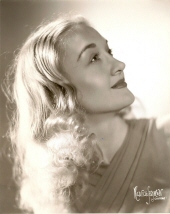
Vonda Urban was an independent teacher of Theosophy based in Chicago, Illinois.
The most impressive thing about Vonda was her impersonal and equal treatment of everyone regardless of their failings as humans, part of Nature's evolution. Absolutely non judgemental.[1]
Early life
Vonda Urban was born as Wanda Urbanovicz on December 8, 1918 in Springfield, Massachusetts. She was the youngest child of Karolina Janik and Michael Urbanovicz. Michael had emigrated from southern Poland in 1904, and Carolina in 1906. They married on November 20, 2013, and settled in Massachusetts, where Michael worked as a baker and later as a salesman.[2][3] Their children were Olga (1914), Irene (1915), Witold (1917), and Wanda (1918).[4]
They didn’t have much money; so young Vonda and her sisters Irene and Olga sold pond lilies and household items door to door to help support the family.
In school, Vonda loved showing off, acting in the school plays and reciting poetry.[5]
Olga moved to Chicago in the early 1930s, followed quickly by her sisters. Vonda and Irene shortened their surname to Urban, and according to their niece, "became city girls. They struck out on their own and made careers for themselves."[6]
They began by selling handmade, silkscreened greeting cards and wrapping paper (even selling it at Marshall Field's). Eventually Irene got married and Vonda, who had studied dance, started teaching at several venues, eventually landing at the preeminent Aragon Ballroom in 1954.[7]
Michael Urbanowicz died in 1942, and his wife Karolina and son Witold moved to Chicago. Vonda and her husband Galen "later took on the responsibility for caring for her brother Witold. To earn a living, and to help support her mother, Vonda worked as a part-time bookkeeper and accountant for many Chicago firms."[8]
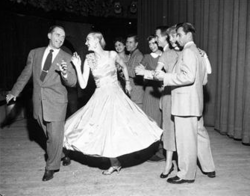
Dance career
Beginning in 1954, the vivacious Vonda Urban taught ballroom dancing at the elegant Aragon Ballroom in Chicago, and became something of a local celebrity. As many as 18,000 patrons visited the venue every week to enjoy the maple dance floor could could hold 8,000 at one time. Six nights a week, radio station WGN broadcast a nationwide hour-long program featuring the famous bands who were playing: the orchestras of Tommy Dorsey, Billy May, Eddy Howard, Teddy Phillips, Dick Jurgens, Chuck Foster, and Buddy Morrow. Lessons in the newest Latin dance styles such as mambo, bossa nova, rhumba, cha cha, and merengue were offered free every Sunday night, and the classic fox trot and waltz on Tuesdays, with Vonda Urban as the instructor. After marrying a band leader and music teacher, Galen Williams, on October 16, 1957, she played drums in his dance band – the first female drummer in that time. They divorced in the 1970s.
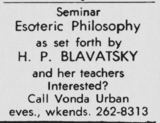
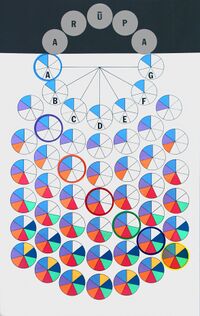
Theosophical work
Vonda Urban was a truly independent student and teacher of Theosophy, associated with Theosophists from the Point Loma tradition, the Adyar Theosophical Society, and others, but did not join the organizations. She worked with the editors of independent Theosophical journals, Boris de Zirkoff's Theosophia and The Eclectic Theosophist, edited by W. Emmett Small and Helen Todd. She also wrote for the academic journal Theosophical History and for the journal of the Theosophical Society in America.
Her mother was interested in spiritualism, and when attending a spiritualist gathering in Chicago, she heard George Cardinal LeGros, a Point Loma Theosophist, speak on Theosophy. She told her daughters Irene and Vonda about him, and this led to their life long involvement with Theosophy.
Vonda and Galen became close friends with Cardinal and his wife Elaine, and spent many evenings together. She called those 10 or 12 years the “wonder years.” At one lecture at Cardinal’s home in Chicago, she met Boris de Zirkoff, the grandnephew of Madame Blavatsky. She would later become a researcher for Boris as he was compiling H. P. Blavatsky’s collected writings and working on his edition of her Secret Doctrine. She found items he needed at the University of Chicago, Newberry Library, and the Field Museum of Natural History. She also helped proofread the final volumes and index of the Collected Writings.[9]
In 1972, Miss Urban began offering classes in "Esoteric Philosophy as set forth by H. P. Blavatsky and her teachers." She advertised in the Daily Northwestern and listed her telephone number in the Yellow Pages of the telephone directory under "Philosopher." She hosted five or six classes a week for the rest of her life. "She also taught an astrology class, where the group would read astrological charts. Altogether she taught approximately 1,000 pupils about the philosophy."[10] One of her students, Jon Knebel, wrote:
Vonda wrote many articles for Theosophical magazines including Theosophia, The Eclectic Theosophist, and Theosophical History. She lectured frequently at the Akbar Lodge in Chicago, and once or twice a year at the Wheaton Illinois headquarters of The Theosophical Society in America, several of the Wheaton lectures having been recorded. Vonda was famous for giving away books, pamphlets and recordings at her lectures, and would often have her audience read along with her as she quoted certain passages. She felt it might encourage them to continue their reading after her lecture was concluded.
Vonda Urban guided and nurtured countless students of Theosophy over the past four decades. Well versed in Theosophy, she was always gentle and caring, always upbeat and inspiring, but also sternly concerned and involved with her fellow students’ growth in the mundane world. She charged us with leading lives that reflected the profound teachings we were studying. Her favorite passage from H. P. Blavatsky’s Voice of the Silence was, “Thou canst not travel on the Path before thou hast become that Path itself.”[11]
Her sister Irene Stashinski worked with her to develop some excellent diagrams depicting Chains and Rounds and other Theosophical concepts. Vonda, Irene, and Vonda's students Arnie Coleman and Norman Zuefle assisted in production of the fourteenth volume of the Collected Writings of Theosophical Society founder H. P. Blavatsky.[12]
Final years
Vonda continued teaching Theosophy almost to the end of her life. She died of pancreatic cancer on June 3, 2011.
Additional resources
Audio
All of the following lectures were delivered at the Theosophical Society in America, in Wheaton, Illinois.
- Helena Petrovna Blavatsky: Messianic Messenger October 1, 1991. Explores the relevance of Madame Blavatsky's life and teachings to modern times. Her handout is not available, but it was comprised of photocopied excerpts from and references to:
- Mahatma Letter 26
- 1888 letter from Koot Hoomi to Olcott
- Constance Wachtmeister's Reminiscences
- Mahatma Letter 44
- 1885 letter from HPB to Patience Sinnett
- H.P. Blavatsky, Tibet, and Tulku by Geoffrey Barborka Wheaton, Illinois: Theosophical Publishing House, 1966.
- Nightmare Tales by H. P. Blavatsky.
- Mahatma Letter 26
- The Voice of the Silence. May 1, 1992. How this classic book of Eastern Wisdom came to be shared with the world.
- Light for the Mind, Love for the Heart, Understanding for the Intellect. October 20, 1994. Spirit, Soul, and Body carry three separate lines of evolution.
- Blavatsky: The Mystery. October 19, 1995. H. P. Blavatsky was called the sphinx of the 19th century. Glimpse the real nature of HPB's world.
- Letters That Have Helped Me: Commemorating William Q. Judge. March 21, 1996. A tribute to Judge on the 100th anniversary of his death. Extracts from his inspirational letters are included.
- Hypnotism: A Psychic Malpractice. October 24, 1996. Comments on hypnotism by H. P. Blavatsky and W. Q. Judge are examined. How is hypnotism different from mesmerism?
- Tribute to H. P. Blavatsky: White Lotus Day 1997 Part 1. May 8, 1997. Recounts H. P. Blavatsky's work and tireless efforts to teach Theosophical principles.
- Tribute to H. P. Blavatsky: White Lotus Day 1997 Part 2. May 8, 1997.
- Ensouling of Our Human Nature. March 27, 1997. Based on insights from Theosophist G. de Purucker, this talk explores ways of living a noble life through a blending of heart and mind.
- Conversations in Occultism. September 25, 1997. H. P. Blavatsky answers W. Q. Judge's questions about the Kali Yuga, our present age. Includes discussion on elementals, mantras, mental discipline, and inner vibrations.
- Psychic and Noetic Action. May 28, 1998. According to the speaker, the brain is both physical and metaphysical. Our daily choice making originates either in selfish or selfless motive, and while the selection is made in our brain-mind, only selfless motives flow from the heart-light.
- Elixir of Life. September 30, 1999. A talk on selected works of H. P. Blavatsky, presenting longevity as a process of spiritual unfoldment based on knowledge and discipline.
- Karma, Reincarnation, and You. October 25, 2001. Through the understanding that everything we experience is the outflow of our own thoughts, emotions, and actions in past lives, we can find a new way to deal with our current challenges and pave the way to mental freedom.
- What Death Really Is Part 1. September 25, 2003. Through the understanding that everything we experience is the outflow of our own thoughts, emotions, and actions in past lives, we can find a new way to deal with our current challenges and pave the way to mental freedom.
- What Death Really Is Part 2. September 25, 2003.
- [ In Honor of H. P. Blavatsky: White Lotus Day Commemoration]. May 5, 2005.
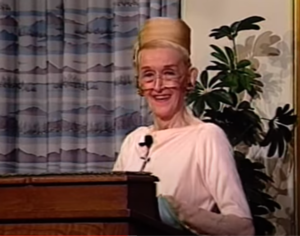
Video
- Helena P. Blavatsky, Messianic Messenger. 1991 at Theosophical Society in America. Handout is not available, but it was comprised of photocopied excerpts from and references to:
- Mahatma Letter 26
- 1888 letter from Koot Hoomi to Olcott
- Constance Wachtmeister's Reminiscences
- Mahatma Letter 44
- 1885 letter from HPB to Patience Sinnett
- H.P. Blavatsky, Tibet, and Tulku by Geoffrey Barborka Wheaton, Illinois: Theosophical Publishing House, 1966.
- Nightmare Tales by H. P. Blavatsky.
- Mahatma Letter 26
Notes
- ↑ Richard Robb in email to Michael Conlin. 2023. Theosophical Society in America Archives.
- ↑ 1920 United States Federal Census.
- ↑ 1930 United States Federal Census.
- ↑ Karolina Janik in 1935 Illinois, U.S., Federal Naturalization Records, 1856-1991.
- ↑ Jon Knebel narrative. Written ca2011. Theosophical Society in America Archives.
- ↑ Deborah Urban, quoted by Becky Schlikerman, "Vonda Urban, 1918-2011" Chicago Tribune June 12, 2011.
- ↑ Becky Schlikerman, "Vonda Urban, 1918-2011" Chicago Tribune June 12, 2011.
- ↑ Jon Knebel narrative. Written ca2011. Theosophical Society in America Archives.
- ↑ Jon Knebel narrative. Written ca2011. Theosophical Society in America Archives.
- ↑ Becky Schlikerman, "Vonda Urban, 1918-2011" Chicago Tribune June 12, 2011.
- ↑ Jon Knebel narrative. Written ca2011. Theosophical Society in America Archives.
- ↑ Preface to Volume XIV, page xxi.